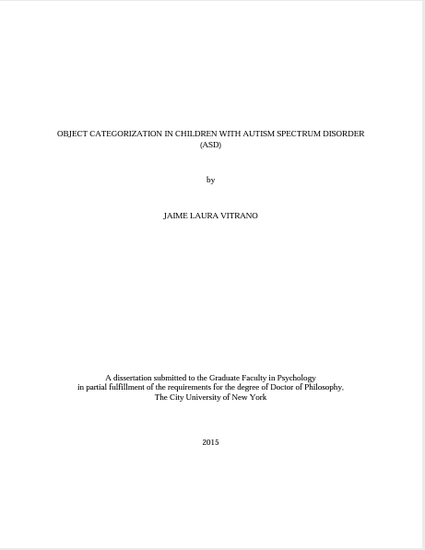
- autism; categorization; cognitive processes; conceptual development
The purpose of this study was to investigate hierarchical object categorization in children with autism spectrum disorder (ASD), examining three levels of category inclusiveness (superordinate, basic, subordinate) across three tasks (sequential touching task, generalized imitation task, sorting task) in three domains (animals, tools, kitchen utensils) in the same group of children with ASD. Previous research on the categorization abilities of children with ASD has shown mixed results. This study was designed to clarify past discrepancies in the literature.
Ten children with ASD participated in this study (mean CA = 4 years, 10 months; range 3 to 6 years; mean VMA = 3 years, 3 months; range 9 months to 6 years, 5 months). In the sequential touching task, children saw objects from two categories, and their spontaneous touching of those objects was recorded. Results showed no differences between category levels. Within level, participants differentiated between animate and inanimate domains on the superordinate level, and categorized basic level animate categories, having more difficulty with subordinate level categories. The generalized imitation task, in which the child must imitate the experimenter's modeled action with an appropriate exemplar, showed that participants generalized significantly better than chance on superordinate and basic level categories, but similar to chance on subordinate level categories. The sorting task, in which the child must sort eight objects (from two categories) into two separate boxes, also revealed no differences between level, but revealed sorting better than chance on the subordinate level only. The proportion of correct sorting was positively correlated with language. A positive correlation was found between the generalized imitation and sorting tasks, suggesting that the tasks may be tapping similar background knowledge. Overall, while children did not show significantly better performance on one level over another, two of the three tasks revealed lowest performance on the subordinate level, a finding that is consistent in typical development. The other task showed that it is possible that children with ASD are showing a different pattern of categorization. The results emphasize the importance of using multiple tasks, as well as multiple levels of category inclusiveness and domains, to study categorization in ASD.
Available at: http://works.bepress.com/jaime-vitrano/6/
